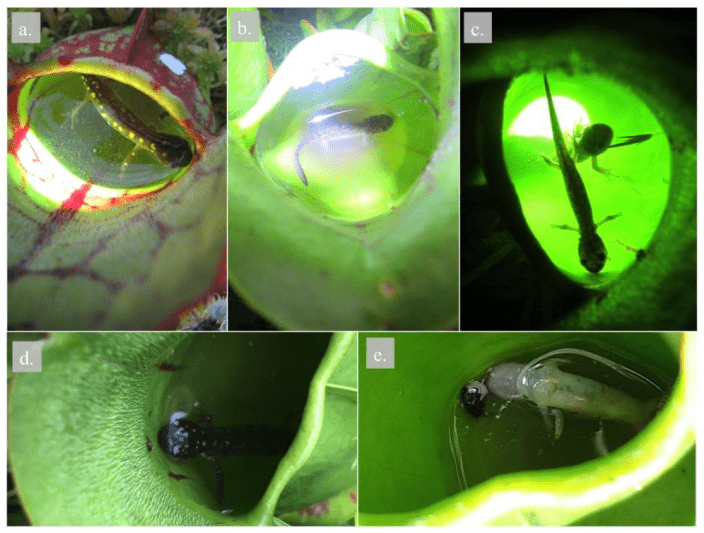In a probable first for North America, researchers at the University of Guelph (U of G), Canada, have discovered meat-eating pitcher plants that dine on young salamanders, not just insects.

Image credits Patrick D. Moldowan et al., (2019),
The bogs in Ontario’s Algonquin Park are rife with deadly plants — if you’re a baby salamander. A new study led by U of G biologist Alex Smith reports on the “unexpected and fascinating case of plants eating vertebrates in our backyard, in Algonquin Park.” The findings, the team explains, may be unique to North America so far.
How the tables have turned
Pitcher plants are well-known for eating animals — but they tend to limit themselves to insects and spiders. This smaller prey is lured into the plants’ bell-shaped leaves, where they are digested in a mixture of rainwater and enzymes. However, until now, nobody had seen these plants capture anything larger. The team found evidence of northern pitcher plants (Sarracenia purpurea purpurea L.) capturing young spotted salamanders (Ambystoma maculatum Shaw) in Canada’s oldest provincial park, Algonquin Park.
The findings are even more surprising, considering that Algonquin is a very popular destination and has been a subject of scientific observations for hundreds of years. Noting how long the park has held this secret — despite generations of visiting naturalists, its proximity to major cities and a highway running through its southern end — Smith said, “Algonquin Park is so important to so many people in Canada. Yet within the Highway 60 corridor, we’ve just had a first.”
The study was borne from a discovery made by then-undergraduate student Teskey Baldwin in 2017 during a U of G field ecology course in the provincial park: he found a salamander inside a pitcher plant. Baldwin is a co-author of the current study. When they returned to monitor pitcher plants in a single pond in the park in the fall of 2018, the team found that roughly 20% of the plants had juvenile salamanders in their pitchers, each about as long as a human finger. Several plants they looked at had more than one captured salamander.
Smith explains that the ponds in this particular bog don’t house fish, making the salamanders a key predator and prey species in the local food webs. The observations also coincided with “pulses” of young salamanders moving onto land after changing from their (aquatic) larval stage. Smith believes that the animals were either lured by insects inside the plants’ pitchers, or they may have entered them in a bid to escape predators.
Some of the trapped salamanders likely died within three days, while others may have lived up to 19 days, the team explains. After expiring, they were broken down by digestive enzymes and other organisms in the water held inside the leaf. Smith said other factors may kill salamanders in pitcher plants, including heat, starvation, or pathogens.
Doesn’t sound like a particularly pleasant fate for the salamanders — so why do the plants put them through all that? Smith says that soil in the bog is relatively nutrient-poor, especially in regards to nitrogen (which is the hard-cap on how much plants can develop in natural environments). Other flesh-eating plants also grow in nutrient-poor environments, he notes, citing sundews and the Venus flytrap.
The only other species of meat-eating pitcher plant (native to Asia) consumes mostly insects and spiders, and occasionally small birds and mice. Smith said the Algonquin Park discovery opens new questions for biologists: are the salamanders a key prey species of the plants? Are the pitcher plants the main predators of these amphibians? And do the two species compete for insects — in which case, might the salamanders outcompete the plants?
“I hope and imagine that one day the bog’s interpretive pamphlet for the general public will say, ‘Stay on the boardwalk and watch your children. Here be plants that eat vertebrates,”‘ Smith quips.
The paper “Salamanders as rich prey for carnivorous plants in a nutrient‐poor northern bog ecosystem” has been published in the journal Ecology.


